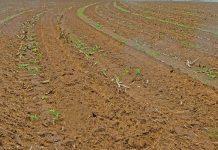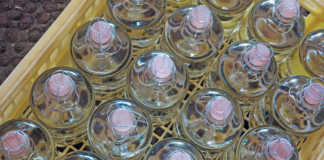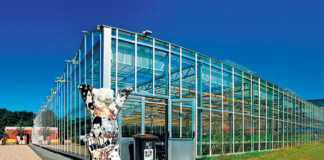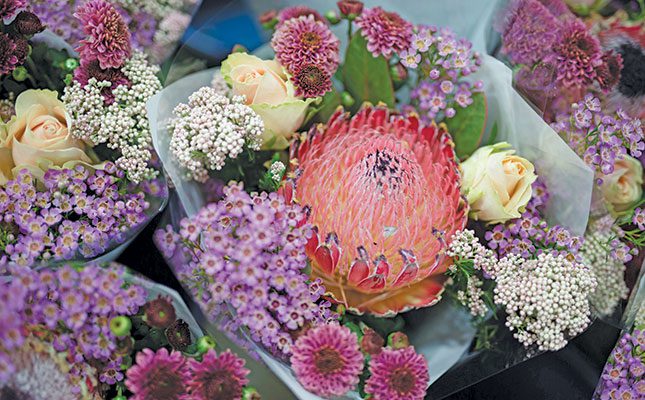
Photo: Supplied by Oak Valley Estate
Anthony Rau of Khiza Farm in Knysna’s Rheenendal says cut-flower farming is a high-intensity production and turnover earned per hectare is high.
“Currently macadamia nut and sunflower farming can deliver similar values. Sunflowers are the biggest crop at Khiza, which I farm with my fiancé, Herman Bosman, and is 3ha in size, with 1,5ha under production.”
Rau tells Farmer’s Weekly that Khiza is both a bunch maker (buying stems from other growers too) and a cut-flower farm. It found early success at Sedgefield’s Wild Oats Market, where they are well-known for their sunflower bouquets.
Planting
“From planting seeds to harvesting sunflowers takes between 60 and 90 days. We buy seed from specialists and as seeds are loved by birds, we plant them in tunnels to germinate. It takes about four days for them to germinate and about a week until they grow to 8cm to 10cm tall.
Then we plant them in rows, 15cm to 30cm from each other, depending on variety. After two to three weeks, it feels like every time you’ve turned your back they have grown 10cm to 15cm a day. Harvesting in summer has to be before 7am. If you cut them at midday they will be dehydrated,” Rau says.
Oak Valley Estate in Elgin in the Western Cape grows nearly 40 different crops and is constantly looking for improved varieties that can optimise the crop’s value. More recent genetic advantages include faster cropping time, heat and drought resistance, viral resistance, fungal resistance, better flower size, longer stems, and better vase life.
Irrigation
“Technology and innovation are required to ensure that Oak Valley Flowers stays a leader in the industry,” says Ruhan von Wielligh, general manager at Oak Valley Estate Flower Division.
“Our greenhouse is climate controlled, ensuring an optimal climate for plant growth that leads to better quality and lower input costs in the form of insecticides, fungicides and energy. We make use of sophisticated, imported irrigation computers that are connected to accurate dosing units to ensure that optimal levels of fertiliser are used.”
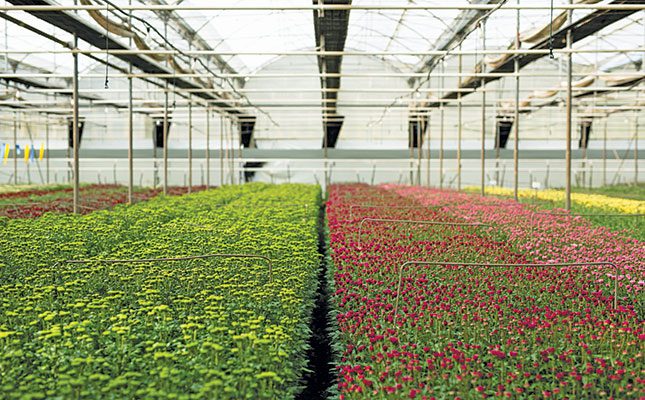
Rau says that as a smaller flower farm they find drip irrigation is the best option.
“Sunflowers are a medium water-usage crop. Drought is a massive issue and overhead watering can lead to fungal disease, especially in a hot period. Electronically set up irrigation can be quite expensive but will save money and time later.”
Von Wielligh says at Oak Valley, soil health is becoming increasingly important to ensure a healthy crop.
“A healthy soil ensures a heathy plant that will be less susceptible to insect and fungal infestations. Our soil-health programme incorporates live bacteria, metabolites, entomopathogenic fungus and parasitic eelworms as part of this strategy. We believe in incorporating large amounts of compost that contributes to soil health while limiting the use of commercial fertilisers. It further improves the air-to-water ratio and water-holding capacity. Regular soil analysis ensures the correct application of fertilisers and lime.”
Inca Lilies
Oak Valley is well known for its Alstroemeria (Inca lilies). “This is a very versatile crop that produces year round under the correct conditions,” says Von Wielligh.
“Oak Valley Flowers decided to venture into growing Alstroemeria due to its popularity among florists and versatility in bouquets, and to develop what was an untapped market at that time. It requires a year-round soil temperature of about 16˚C, high light intensity, and moderate air temperatures and humidity. An artificial climate is thus created using a greenhouse facility that has a soil cooling system, plastic covering that is highly translucent and with forced ventilation with a wet wall to drop the temperature and raise the relative humidity. Plants are replaced on a six-year cycle to ensure optimal production.”
Select for microclimates
It is of utmost importance that the crops you select to grow are selected to your region’s climate, even down to your farm’s microclimate, he adds.
“Artificially changing the climate with green house infrastructure and possibly heating changes the economy of the crop. Such investments can only be made for very high-value crops.
“Seasonal changes determine the crop type that can be grown. Varietal changes on a selected crop optimises the quality of the crop and must never be underestimated. Do trials on your farm to find the most suitable varieties for the different times of the year,” says Von Wielligh.
Rau says what to plant really depends on where you are located. “Context is important here. South Africa has many different climate zones. Coastal areas will be better for fynbos, proteas and individual King, Sylvia, Pink Ice and Lancelot, which are all types of protea.
“We have a lot of clay soil on our farm, which is not ideal for fynbos. When it comes to non-fynbos, there is a debate around two main options, open-ground growing and curated cultivation under plastic or shade netting. Sunflowers are popular for open-ground planting.”
High-value crops
Rau says gerbera, an indigenous daisy-shaped flower, is especially valuable as it comes in about 50 different shades and lasts for a long time in the vase.
“Typically, highly hybridised plants can be a pest magnet, so don’t plant a runway for grasshoppers or other pests.
“Crop rotation is important; we do a lot of natural composting and plant lavender in every third bed, which is a good pest deflector,” says Rau.
“Marigolds are a sacrificial crop that is resilient to snails, which hammer it instead of the sunflowers. We champion diversity in planting which also limits massive pests attacks.”
Oak Valley has about 16ha under production, which includes chrysanthemums, Alstroemeria, lilium, other bulb crops, seasonal flowers and greenery.
“This makes up a balanced basket of products out of which florists, chain groups and bunch makers can select. In the past years, the rise in input costs has far outweighed the rise in income, which puts an enormous amount of pressure on the sustainability of flower production.
“We were forced to look at our entire range and had to make difficult decisions regarding non-profitable crops. Investments were made to improve the yield and quality and thus ensuring a better income per square metre,” Von Wielligh says.
Blemish-free
“Oak Valley’s cut flowers are very much a product bought for its appearance, and blemishes or insect activity are not accepted at all. A disease management plan is thus required to achieve this. Such a plan will included climate control, varietal selection, soil and plant heath, irrigation schedules worked out with weather data and soil moist in mind, and much more,” Von Wielligh says.
“As mentioned before, a well cared for plant will require little pest control and in most cases can be supported by a biological approach.
“The life cycle of year-round crops like liliums, Alstoemeria and other unheated crops is determined by the combined day and night temperatures and in some cases also day length. A summer crop takes about 12 weeks from planting to harvesting, while a crop planted in May can take up to 25 weeks to reach maturity. This has a major effect on soil utilisation and planning.”
He adds that a good start is vital.
“If the plant or bulb develops a strong root system from day one, it has a much better chance of succeeding. A moist, soft, well-aerated soil is required to do so. Water and fertiliser are adjusted to the climate and age of the plant. Most crops need to be staked to prevent it from falling over.”
He says stem length is of crucial importance if the product is to be used in flower arrangements.
No-till agriculture
Rau says that at Khiza, they support no-till agriculture. “This has changed our system of planting. Generally speaking, cut-flower growing is not mechanised, so we use manual harvesting. We only use organic and natural compost and fertiliser. People are more conscious about the footprint of their purchases. We use the eco-system model, which tries to replicate what happens in nature.”
Mycorrhizal growth in the fungal network that connects plants in a symbiotic relationship plays a much bigger role than initially thought.
Rau says that as some flowers are ethylene sensitive, they must be displayed away from fruit, especially bananas or potatoes, and also away from direct sunlight.
“In the flower industry, if you supply a few other industries like eventing, vase life is less important than if you supply a retailer, as a bride wants her flowers open on the wedding day. At a retailer, try to buy a bunch with as many closed buds as possible, which will last the longest,” he says.
Brand values
According to Von Wielligh , Oak Valley Flowers is a brand built on quality, longevity and customer service.
“Customers deserve value for their money, and a product that gives you days of pleasure must be delivered. Consistency in supply of a quality product ensures that you become a preferred supplier to many florists, wholesalers and retail groups, which also gives you the opportunity of asking a premium price.”
Rau says there is a potential gold mine for cut flowers in markets in Europe, China and elsewhere. “Flowers are generally airfreighted from South Africa. Considering our price advantage in South Africa and the price value of flowers in Europe, we could be a big exporter.”
Post-harvest treatment
Oak Valley says post-harvest cooling must happen as soon as possible. “Clean water must be available and in many cases a product-specific post-harvest water treatment must be given to boost water uptake and prevent leaf yellowing, petal drop and more. We strive to deliver all our floristry products in buckets of water. Special trolleys have been made to ensure the best utilisation of truck space without compromising the flower quality. Our trucks are all insulated and cooled to ensure that the cold chain remains.
“Flowers that are exported or shipped to customers outside of our reach also receive post- harvest treatment and will only be packed in boxes after they are fully hydrated. We use forced cooling units to ensure that the content is at its optimal temperature before shipment. The use of temperature loggers is important to evaluate the logistical side of things,” says Von Wielligh.
Rau says the direct-to-client trend, which includes deliveries from the farm, is big now, as is the experience of people wanting to visit farms.
What retailers say
A spokesperson for Woolworths says that cut flowers, and indeed their full horticulture range, are important to Woolies customers, particularly around special occasions. Some popular choices include bouquets, orchids, fynbos and roses.
“As an extension of our commitment to quality, we introduced a guarantee on how long our fresh-cut flowers will last. Customers are afforded peace of mind that if any flowers don’t last, we will gladly replace them. This was a step we took 10 years ago, making Woolworths the first retailer to do so.
“We work closely with our suppliers to ensure our horticultural range is up to a standard we are proud of. Quality, sustainability and consistency are just three factors we prioritise when working with our farmers and growers,” Woolworths says.
Visit capeflorasa.co.za.









